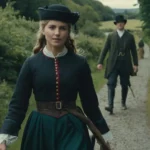Irish traditional clothing is a beautiful representation of the country’s rich history, culture, and folklore. Rooted in ancient Celtic traditions and later influenced by medieval and rural lifestyles, Ireland’s folk attire reflects a profound connection to its natural environment and vibrant heritage. From the iconic Aran sweaters to tweeds and intricate lacework, Irish clothing continues to inspire pride and creativity in modern fashion.

Historical Origins of Irish Traditional Clothing
The evolution of Irish attire is deeply tied to the island’s history and geography. The clothing reflects a mix of practicality and artistic expression that has endured for centuries.
Early Celtic Influence
- Léine (Tunic): In ancient Celtic Ireland, both men and women wore a léine, a long tunic made of linen or wool, often dyed with natural pigments such as saffron, madder, or woad.
- Brats (Cloaks): These were versatile, multi-purpose cloaks fastened with brooches, offering protection against Ireland’s famously wet climate.
- Materials: Clothing was crafted from locally sourced wool and linen, with natural dyes creating earthy tones like green, yellow, and ochre.



Medieval Period
During the medieval period, clothing became more tailored, with garments featuring elaborate embroidery and regional styles. The use of wool remained predominant, but linen and silk became accessible to wealthier classes.
Rural and Peasant Influence
In the 18th and 19th centuries, traditional Irish clothing was heavily influenced by rural life. Practicality became essential, with simple, durable garments designed to withstand labor-intensive lifestyles and harsh weather conditions.
See also Exploring the Charm of Traditional Clothing in Scotland
Exploring the Charm of Traditional Clothing in ScotlandKey Elements of Irish Folk Attire
Men’s Traditional Irish Clothing


Men’s traditional clothing combines functionality with a distinctive Irish charm, emphasizing natural fibers and timeless designs.
- 🧥 Tweed Jackets and Waistcoats: Tweed became synonymous with Irish menswear. Crafted from handwoven wool, these garments were designed for warmth and durability, often featuring herringbone or check patterns.
- 🎩 Flat Caps: Also known as Irish caps, these iconic headpieces protected men from the elements while adding a touch of style.
- 👖 Breeches and Stockings: Woolen breeches paired with knitted stockings were common, especially for farmworkers and laborers.
- 🥾 Leather Shoes: Sturdy and often handmade, these shoes were built for Ireland’s rugged terrain.
Women’s Traditional Irish Clothing


Women’s attire is characterized by elegance, intricate patterns, and a connection to Irish craftsmanship.
- 👗 Long Dresses: Made from wool or linen, these dresses often featured high necklines and long sleeves, reflecting modesty and practicality.
- 🧣 Shawls: Women wore hand-knitted or woven shawls, often made of soft wool, to protect against the cold. Shawls were both decorative and functional, showcasing traditional patterns.
- 🧵 Lacework: Ireland is renowned for its delicate lace, particularly Carrickmacross and Kenmare lace, which adorned collars, cuffs, and headdresses.
- 💍 Claddagh Rings and Brooches: Jewelry like the Claddagh ring symbolized love, loyalty, and friendship, while brooches were often used to fasten cloaks and shawls.
Regional Variations in Irish Traditional Clothing

Aran Islands
The Aran sweater, with its intricate cable-knit patterns, originated on the remote Aran Islands. These sweaters, made from untreated wool, were not only warm but also water-resistant, ideal for fishermen facing the Atlantic winds.
- Patterns with Meaning: Each family had unique sweater patterns, which could identify lost sailors.
- Accessories: Woolen caps and gloves completed the outfit, reflecting the islanders’ resourceful craftsmanship.
County Donegal
- Tweed Tradition: Donegal is famous for its tweed, with distinctive speckled patterns created by blending various colors of yarn.
- Practical Garments: Men’s jackets and women’s cloaks were designed for warmth and ruggedness, ideal for the county’s often harsh weather.
West Ireland (Galway and Clare)
- Lace and Embroidery: The western regions are known for their intricate lacework, which adorned women’s Sunday attire.
- Vivid Colors: Dresses often featured bright reds and greens, inspired by the natural landscape and folklore.
Cultural Significance of Irish Traditional Attire
Festive Wear and Folk Dances
Traditional clothing holds a special place in Irish festivals and dances. During Céilí dances and St. Patrick’s Day parades, participants often wear folk costumes to celebrate Irish heritage.
See also Traditional Clothing in Wales: A Tapestry of Heritage and Craftsmanship
Traditional Clothing in Wales: A Tapestry of Heritage and Craftsmanship- Women might don embroidered dresses with lace accents.
- Men typically wear tweed suits or Brian Boru jackets—a style named after Ireland’s high king.
Symbolism in Irish Clothing
Irish attire carries deep symbolic meaning. For instance, the Claddagh ring is not just jewelry; it represents love and loyalty. Similarly, the patterns on Aran sweaters tell stories of protection, luck, and family legacy.
Modern Interpretations
In modern times, Irish traditional clothing has been reimagined by designers who incorporate elements like tweed, lace, and Aran knitting into contemporary fashion. This fusion ensures the survival and relevance of these time-honored traditions.
Preservation Efforts and Legacy


Museums and Exhibitions
Institutions like the National Museum of Ireland play a vital role in preserving and showcasing traditional Irish garments. These collections offer insights into the artistry and functionality of the clothing.
Craft Revivals
Workshops in places like Donegal and the Aran Islands teach younger generations the art of weaving, knitting, and lace-making, ensuring these skills are not lost.
Global Recognition
Irish traditional clothing, particularly Aran sweaters and tweed, has gained international acclaim, symbolizing Ireland’s cultural legacy on a global stage.
A Heritage Woven into Fabric
Irish traditional clothing is a celebration of history, craftsmanship, and identity. From the rugged charm of tweed to the intricate beauty of lace, every piece tells a story of resilience and pride. As Ireland continues to honor its past while embracing the future, its folk attire remains a timeless reminder of the nation’s vibrant culture and enduring spirit.
